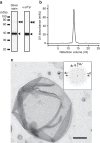The four-transmembrane protein IP39 of Euglena forms strands by a trimeric unit repeat
- PMID: 23612307
- PMCID: PMC3644091
- DOI: 10.1038/ncomms2731
The four-transmembrane protein IP39 of Euglena forms strands by a trimeric unit repeat
Abstract
Euglenoid flagellates have striped surface structures comprising pellicles, which allow the cell shape to vary from rigid to flexible during the characteristic movement of the flagellates. In Euglena gracilis, the pellicular strip membranes are covered with paracrystalline arrays of a major integral membrane protein, IP39, a putative four-membrane-spanning protein with the conserved sequence motif of the PMP-22/EMP/MP20/Claudin superfamily. Here we report the three-dimensional structure of Euglena IP39 determined by electron crystallography. Two-dimensional crystals of IP39 appear to form a striated pattern of antiparallel double-rows in which trimeric IP39 units are longitudinally polymerised, resulting in continuously extending zigzag-shaped lines. Structural analysis revealed an asymmetric molecular arrangement in the trimer, and suggested that at least four different interactions between neighbouring protomers are involved. A combination of such multiple interactions would be important for linear strand formation of membrane proteins in a lipid bilayer.
Figures






References
-
- Van Itallie C. M. & Anderson J. M. Claudins and epithelial paracellular transport. Annu. Rev. Physiol. 68, 403–429 (2006) . - PubMed
-
- Taylor V., Welcher A. A., Program A. E. & Suter U. Epithelial membrane protein-1, peripheral myelin protein 22, and lens membrane protein 20 define a novel gene family. J. Biol. Chem. 270, 28824–28833 (1995) . - PubMed
-
- Van Itallie C. M. & Anderson J. M. The molecular physiology of tight junction pores. Physiology 19, 331–338 (2004) . - PubMed
-
- Grey A. C., Jacobs M. D., Gonen T., Kistler J. & Donaldson P. J. Insertion of MP20 into lens fibre cell plasma membranes correlates with the formation of an extracellular diffusion barrier. Exp. Eye Res. 77, 567–574 (2003) . - PubMed
Publication types
MeSH terms
Substances
LinkOut - more resources
Full Text Sources
Other Literature Sources

